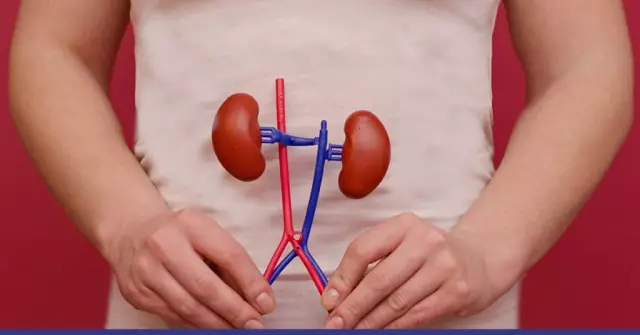- Author Rachel Wainwright [email protected].
- Public 2023-12-15 07:39.
- Last modified 2025-11-02 20:14.
Tubo-otitis

Hearing is one of those functions that allows a person to receive information about the world around him. Just like sight, hearing is the most important mechanism for research and knowledge of the surrounding world. The human ear is a complex organ, its physiology and structure are aimed at the perception of sound waves in the range of 16 Hz-22 kHz.
The mechanism of sound perception by the human ear can be roughly divided into two parts:
- mechanics - the auditory canal, auricle, ossicles, eardrums;
- electrical - the auditory center of the cerebral cortex, the auditory nerve.
Through the auditory canal, the sound enters the eardrum, after which it is amplified many times with the help of the auditory ossicles, and in the cochlea of the internal sound from the vibration of the air, the sound turns into the vibration of the liquid and is converted into an electrical signal with the help of special nerve cells. In order for the hearing to function fully, the coordinated work of all the constituent parts of the human ear is necessary.
What is tubo otitis?
Tubo-otitis is a catarrhal inflammation of the mucous membrane of the inner ear, which develops as a result of dysfunction of the auditory tube.
The auditory ossicles are located in the air cavity (middle ear) in the very thickness of the temporal bone, and for their full functioning, the pressure in the middle ear must be the same as in the environment. For this to happen, the air cavity must communicate with the environment, which happens with the help of a special education - tuba auditiva (auditory tube). The auditory tube opens into the nasopharynx and in adults its length is 3.5 cm, and in newborns - 2 cm. When there is a dysfunction of the auditory tube, a disease occurs, which is called tubo-otitis (eustachitis).
Many other names are also used to define this disease: tubotympanitis, salpingootitis, catarrhal otitis media (acute or chronic).
Causes of tubootitis
The main cause of tubo-otitis is an infectious process in the mouth of the pipe. The infection enters the tube from the nasal cavity. So, acute rhinitis can lead to swelling of the nasal mucosa, including in the mouths of the auditory tubes, as a result of which there is an obstruction of the auditory tube. The obstruction of the tube, in turn, makes it impossible to equalize the pressure in the tympanic cavity, which leads to impaired mobility of the auditory ossicles and such a sign as ear congestion.
Often, with a runny nose or strong blowing of the nose, mucus gets into the mouth of the auditory tube, which is the reason for the development of tubo-otitis. Therefore, with acute sinusitis and rhinitis, it is important to blow your nose correctly. When blowing your nose, you must open your mouth and pinch one half of your nose.
It happens that the cause of tubootitis is a persistent dysfunction of the auditory tube with vasomotor rhinitis. In this case, tubo-otitis can be called a complication of vasomotor rhinitis. Such tubo-otitis is difficult to treat, and it is characterized by the formation of persistent edema in the region of the posterior end of the lower auditory concha with spread to the mouth of the auditory tube. Treatment of tubo-otitis in this case must be combined with the treatment of vasomotor rhinitis.
In children, tubo-otitis is often bilateral. In adulthood, tubo-otitis is more often observed from the painful side.
Symptoms of tubo-otitis
The main symptoms of tubo-otitis are hearing loss, a feeling of congestion, and periodic noise in the ear. Sometimes autophony is observed when a person hears an echo of his own voice in a sore ear. The same complaints are typical for acute respiratory infections. Congestion in the ear can occur during changes in atmospheric pressure (for example, when flying in an airplane). With tubo-otitis, pain in the ear can be intense or insignificant, and the patient's general condition suffers little.
When conducting an otoscopy, the patient has such a symptom of tubo-otitis as retraction of the tympanic membrane. Auditory activity decreases moderately (by 20-30 dB). Also, the symptoms of tubo-otitis include patient complaints about hearing improvement after yawning or swallowing saliva. This occurs as a result of the temporary opening of the lumen of the auditory tube.
In children, tubo-otitis is accompanied by an increase in temperature up to 38 degrees or more. Chills, a feeling of ear congestion, noise in the ear, hearing impairment appear. In this case, pain can appear both immediately and after a while. When examining the auricle with tubootitis in children, redness and swelling of the auricle is noticeable. Often, bubbles appear on the surface of the external auditory canal.
Complications of tubo-otitis
Often, tubo-otitis is sluggish and accompanied by mild symptoms, as a result of which patients are not inclined to immediately run to the doctor. Naturally, late detection and treatment of tubo-otitis can lead to various complications, namely: persistent dysfunction of the auditory tube, when negative pressure forms in the ear cavity and exudate begins to accumulate. In turn, this becomes the cause of the adhesion process between the auditory ossicles, and persistent hearing impairment occurs.

If negative pressure is present in the middle ear cavity for a long time, irritation of the cochlea occurs, as a result of which degenerative changes in the auditory nerve appear, and sensorineural hearing loss occurs. In addition, suppuration of exudate can occur at any time, which results in acute purulent otitis media, which, in turn, is also fraught with formidable complications.
Treatment of tubo-otitis
First of all, the treatment of tubo-otitis should be aimed at eliminating those factors that contribute to the obstruction of the auditory tube. In order to reduce the edema of the mucous membrane in the ear, the patient is prescribed vasoconstrictor nasal drops: sanorin, naphthyzin, nasivin, tizin, etc. Antihistamines (gismanal, suprastin, claritin, etc.) also relieve edema.
In order to prevent the ingress of infectious mucus through the auditory tube from the nasopharynx into the tympanic cavity, the patient is taught to blow his nose correctly, and may also be prescribed to blow the auditory tubes according to Politzer. A good therapeutic effect is produced by catheterization of the auditory tube, which is done after anemization of the pharyngeal opening. A couple of drops of 0.1% adrenaline solution or hydrocortisone suspension are injected into the auditory tube through the catheter.
In the treatment of tubo-otitis, a number of physiotherapeutic measures are also prescribed: laser therapy for the area of the mouth of the auditory tube, UHF on the nose, UFO, pneumomassage of the tympanic membrane.
With adequate and timely treatment, acute tubo-otitis is cured in a few days. The effectiveness of the treatment of chronic tubo-otitis depends on the timely elimination of pathologies of the nasopharynx, paranasal sinuses and nasal cavity, which cause the constant occurrence of the disease.
YouTube video related to the article:
The information is generalized and provided for informational purposes only. At the first sign of illness, see your doctor. Self-medication is hazardous to health!






